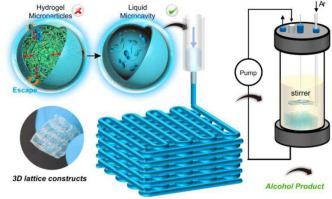当前位置:
X-MOL 学术
›
Chem. Eng. J.
›
论文详情
Our official English website, www.x-mol.net, welcomes your feedback! (Note: you will need to create a separate account there.)
Enzyme induced polymer degradation as a pathway to create microbial habitats for biomanufacturing intensification
Chemical Engineering Journal ( IF 13.3 ) Pub Date : 2024-06-29 , DOI: 10.1016/j.cej.2024.153622 Wei Cheng , Huilin Wen , Haixia Shen , Chenwei Fu , Erkuang Miao , Dongbao Li , Xiaoqiang Chen , Chi Hu , Ziyi Yu
Chemical Engineering Journal ( IF 13.3 ) Pub Date : 2024-06-29 , DOI: 10.1016/j.cej.2024.153622 Wei Cheng , Huilin Wen , Haixia Shen , Chenwei Fu , Erkuang Miao , Dongbao Li , Xiaoqiang Chen , Chi Hu , Ziyi Yu

|
Polymer hydrogels are instrumental in cell immobilization for biomanufacturing, yet traditional hydrogel bioreactors often compromise cell viability, function, and mass transfer. This results in uncontrolled microbial proliferation and significant cell leakage, thereby impeding the continuous production of high-value products. To address these challenges, we introduce an innovative liquid microcavity technique employing a blend of Gelatin-methacryloyl (Gel-MA) and Pluronic F127diacrylate (F127-DA) for precision bioprinting, followed by selective enzymatic digestion of gelatin to create microbial habitats. Through tailoring of the hydrogel’s pore structure and integration of diverse networks, our approach facilitates controlled nutrient transfer, efficient waste removal, and stable mechanical support, all while maintaining a leak-free suspension culture of microorganisms. We validated the effectiveness of our method by fabricating yeast-infused Three-dimensional (3D) lattice constructs, successfully achieving continuous fermentation of glucose into ethanol in a flow reactor with minimal efficiency reduction (≥90 % yield) over five cycles. This research not only confronts the spatial limitations inherent in hydrogel-based systems but also demonstrates a foundational potential for revolutionary change in biomanufacturing practices.
中文翻译:

酶诱导的聚合物降解是为生物制造集约化创造微生物栖息地的途径
聚合物水凝胶在生物制造的细胞固定方面发挥着重要作用,但传统的水凝胶生物反应器通常会损害细胞活力、功能和传质。这会导致不受控制的微生物增殖和严重的细胞泄漏,从而阻碍高价值产品的连续生产。为了应对这些挑战,我们引入了一种创新的液体微腔技术,采用明胶甲基丙烯酰 (Gel-MA) 和 Pluronic F127二丙烯酸酯 (F127-DA) 的混合物进行精密生物打印,然后对明胶进行选择性酶消化以创建微生物栖息地。通过定制水凝胶的孔隙结构和整合不同的网络,我们的方法促进了受控的营养物转移、有效的废物去除和稳定的机械支撑,同时保持微生物的无泄漏悬浮培养。我们通过制造注入酵母的三维 (3D) 晶格结构验证了我们方法的有效性,成功实现了在流动反应器中将葡萄糖连续发酵为乙醇,并且在五个循环中效率降低最小(≥90% 产率)。这项研究不仅面临基于水凝胶的系统固有的空间限制,而且还展示了生物制造实践革命性变革的基本潜力。
更新日期:2024-06-29
中文翻译:

酶诱导的聚合物降解是为生物制造集约化创造微生物栖息地的途径
聚合物水凝胶在生物制造的细胞固定方面发挥着重要作用,但传统的水凝胶生物反应器通常会损害细胞活力、功能和传质。这会导致不受控制的微生物增殖和严重的细胞泄漏,从而阻碍高价值产品的连续生产。为了应对这些挑战,我们引入了一种创新的液体微腔技术,采用明胶甲基丙烯酰 (Gel-MA) 和 Pluronic F127二丙烯酸酯 (F127-DA) 的混合物进行精密生物打印,然后对明胶进行选择性酶消化以创建微生物栖息地。通过定制水凝胶的孔隙结构和整合不同的网络,我们的方法促进了受控的营养物转移、有效的废物去除和稳定的机械支撑,同时保持微生物的无泄漏悬浮培养。我们通过制造注入酵母的三维 (3D) 晶格结构验证了我们方法的有效性,成功实现了在流动反应器中将葡萄糖连续发酵为乙醇,并且在五个循环中效率降低最小(≥90% 产率)。这项研究不仅面临基于水凝胶的系统固有的空间限制,而且还展示了生物制造实践革命性变革的基本潜力。











































 京公网安备 11010802027423号
京公网安备 11010802027423号